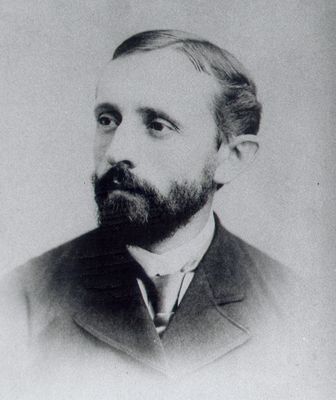Richard Roschman
Richard Roschman (pictured right) stowed away on a ship near
the end of the Franco-Prussian war to avoid joining the army.
Fortunately when the 23-year-old German tool maker announced
his presence to the ship’s captain, he agreed to let Roschman work
for his passage to Canada.
When Roschman arrived in Quebec on March 23, 1871, the captain told him to head to Berlin, Ontario where he would find many of his countrymen.
Berlin supported a thriving button industry at the time with five local factories. Roschman began working at the Vogelsang and Shantz Button Factory, one of the first of its kind in Canada, shortly after settling in the area.
After learning the trade, Roschman decided to open the first button
business in Waterloo in 1878 with partner Daniel Bowman. When
his brother Rudolph arrived, he began working there
as well, and by 1884 the Roschman brothers were in business together.
The Roschmans were just two of thirteen children born in Ulm,
Germany, to a prominent soap manufacturing family.
“(Richard Roschman) came to the New World with little capital,
but with strong determination and by unfaltering energy and perseverance he has worked his way upward in the business world from a humble financial position to one of affluence.”
As the business grew, the Roschmans built a new factory in the late 1880s on what is now Regina Street in Uptown Waterloo. The historic factory has been designated a heritage landmark and is being used by the Waterloo Community Arts Centre. It is generally described as “Mennonite Georgian” and is considered to be an excellent example of a late nineteenth-century industrial building.
By 1900, more than one hundred men and women were making everything from buttons to buckles and cufflinks. A Waterloo woman who worked at the factory as a 14-year-old remembers: “It was dirty work, the shells were brittle and sandy, I sorted them and put them in baskets, then men carried them away to be stamped into buttons. There were a lot of young people working there; the girls sat at long tables to sort and grade. I made $5 a week.”
Some of the material for the buttons came from nuts grown in the swamps of South America. The nuts were ivory coloured and could be dyed after being dried, cut, and tumbled in wooden drums. The Roschman factory also used iridescent pearl shells from Japan which were soaked and then cut into discs before being polished and ground against a revolving whetstone.
“Passers-by would often see the heaps of shells piled in the factory’s yard. When the discarded shells accumulated to form a large heap, they were hauled away to be used as clean landfill.”
Business was good to Richard and Rudolph for many years; both of them married and raised children in the community. They were also actively involved in the Swedenborgian Church of the New Jerusalem on King Street.
However, their fortunes began to change when cheap plastic buttons from Japan flooded the North American market, making it difficult for the brothers to compete. As well, hand-tailored suits were being replaced by machine-made clothing that needed the symmetrical plastic buttons for the assembly-line. The use of zippers cut further into their market, and by the mid-1940s the Roschman button factory was shut down.
Photo courtesy of Waterloo Public Library.
Richard Roschman (Waterloo 150 Profile)
Description
- Creator
- Gallagher, Beth, Author
- Media Type
- Text
- Image
- Description
- To celebrate Waterloo's 150th anniversary, the Waterloo Public Library published a book called "Profiles from the Past, Faces of the Future." This book featured 150 profiles of people who helped make Waterloo what it is today. This is the digitized profile for Richard Roschman.
- Notes
- Please visit the Waterloo Public Library to enquire about physical copies of "Profiles from the Past, Faces of the Future."
The Waterloo 150 project was funded by a grant from the Waterloo Regional Heritage Foundation. Beth Gallagher wrote the profiles with the assistance of many research volunteers. Information for the profiles was gathered from a variety of sources from the community and the Ellis Little Local History Room. Notable sources include the Ellis Little Papers, newspaper clippings, local magazines and books.
- Place of Publication
- Waterloo, Ontario
- Date of Publication
- 2007
- Subject(s)
- Personal Name(s)
- Roschman, Richard ; Bowman, Daniel ; Roschman, Rudolph
- Corporate Name(s)
- Vogelsang and Shantz Button Factory
- Language of Item
- English
- Geographic Coverage
-
-
Ontario, Canada
Latitude: 43.4668 Longitude: -80.51639
-
- Copyright Statement
- Uses other than research or private study require the permission of the rightsholder(s). Responsibility for obtaining permissions and for any use rests exclusively with the user.
- Contact
- Waterloo Public LibraryEmail:askus@wpl.ca
Website:
Agency street/mail address:35 Albert Street, Waterloo, Ontario, Canada, N2L 5E2
- Full Text




